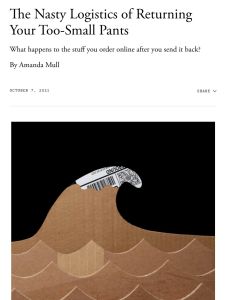Join getAbstract to access the summary!

Join getAbstract to access the summary!
Amanda Mull
The Nasty Logistics of Returning Your Too-Small Pants
What happens to the stuff you order online after you send it back?
The Atlantic, 2021
What's inside?
Shopping from home is so convenient! But product returns are a nightmare — for businesses and for the planet.
Recommendation
Few businesspeople care to discuss – and consumers rarely give a second thought to – the economic and environmental costs of product returns. Writing in The Atlantic, Amanda Mull explains how the “free shipping, free returns” model of online commerce enables customer overbuying, resulting in a glut of returned merchandise and logistical burdens on businesses. Retailers discard or destroy up to 25% of returns rather than restock, resell or donate them.
Summary
About the Author
The Atlantic staff writer Amanda Mull frequently reports on consumer behavior and business trends.



















Comment on this summary